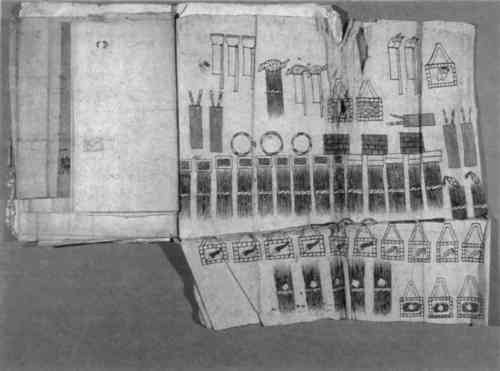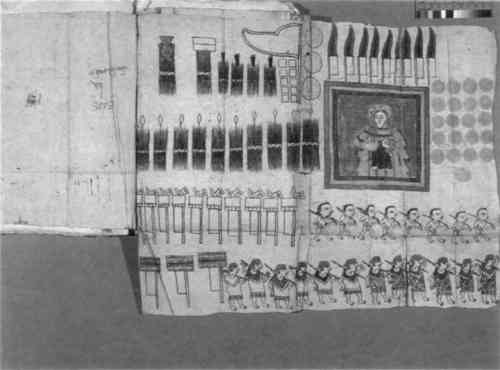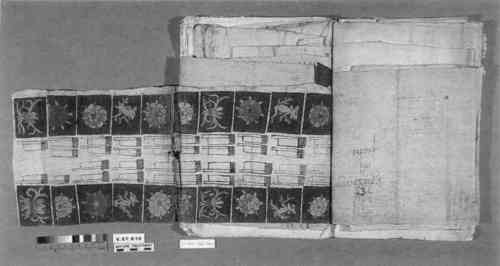THE EXAMINATION AND CONSERVATION TREATMENT OF THE LIBRARY OF CONGRESS HARKNESS 1531 HUEJOTZINGO CODEX
SYLVIA RODGERS ALBRO, & THOMAS C. ALBRO
1 INTRODUCTION
ALONG WITH the Library of Congress's most valuable and important collection of Spanish American manuscripts and documents, the 1531 Huejotzingo Codex (fig. 1) was presented to the Library by the American philanthropist Edward Stephen Harkness in 1928–29 (Library of Congress 1974, v). The 79-leaf manuscript includes eight Mexican Nahuatl pictographs sewn into the center of the binding and consists of the proceedings of a lawsuit brought by Hernando Cort�s against members of the first audiencia (supreme court) of Mexico in 1531–32. Three Spaniards were accused of attempting to take over Cort�s's properties and powers in Mexico during his return visit to Spain in 1528 (Library of Congress 1974, 49). These Spaniards are identified as Nu�o de Guzm�n, president of the first audiencia in Mexico, and licentiates Juan Ortiz de Matienzo and Diego Delgadillo, oidores. Cort�s charged that during his absence the president and oidores (judges) of the first audiencia unjustly and improperly collected for themselves the tributes of goods and services that belonged to Cort�s from the Indians of the town of Huejotzingo.1 Specific details of the tributes and services that the Indians were forced to give the accused in Cort�s's absence are shown on the eight paintings on native papers (figs. 2, 4, 8). These unusual pictographs give the manuscript the ethnohistorical designation of “codex,” which differs from the definition of “codex” used by conservators and librarians. The former focuses on pictorial content, and the latter on book structure and format.2 One of the most interesting images is a Nahuatl illustration of the Christian Madonna and child, which the manuscript text describes as the design for a banner made by the Indians for Nu�o de Guzm�n, a conquistador, and which is one of the earliest extant Christian images made in the New World (fig. 4) (Library of Congress 1974, 109).3
Fig. 1.
Harkness 1531 Huejotzingo Codex as it appeared before treatment. Front leaves had separated from the manuscript text block and had been individually lined on both sides with silk (not in photo). The sewing structure is not unusual for a legajo, a Spanish 16th-century legal document. The folded Nahuatl Indian drawings, sewn into the center of the manuscript, are visible protruding from the front edge.
 |
Fig. 2.
The Nahuatl drawing no. 1 in the manuscript as it appeared before treatment. The symbols represent quantities of turkeys, clay, beans, bricks, rope, bricks, corn, and chili peppers. These form part of the tribute that is disputed in the lawsuit. Paper fiber is amatl.
 |
Fig. 4.
Drawing no. 7 as it appeared before treatment. The Christian image, made by Nahuatl Indians, is one of the earliest of its kind (1531). Pictographic symbols include feathers and gold, which were to be used in making a banner with the image of the Madonna and Child. Paper fiber is maguey.
 |
Fig. 8.
Drawing no. 4 as it appeared before treatment. Red color is presumed to be cochineal. Paper fiber is maguey.
 |
The mest�zo character of the manuscript—the combination of both European and Indian accounts of early events in 16th–century Mexican history—gives the piece a particular significance. Early native materials are rare, as many Indian pictographic books did not survive the conquest period (Lenz 1961). As the 500th anniversary celebration of the European discovery of America draws near, attention is focused on the study of early documents such as the Huejotzingo Codex which present an eyewitness view of the first cultural mixes in the New World.
Until 1925, the 1531 Huejotzingo Codex was part of the private archive belonging to the descendants of Cort�s (the Italian dukes of Monteleone) and was housed in the Hospital de la Immaculada Concepci�n y de Jes�s Nazareno in Mexico City together with other documents related to Cort�s and his family. Sometime after 1925 the manuscript was sold along with other papers by a Monteleone descendant to the dealer A.S.W. Rosenbach, who then sold a partial collection of the papers to Harkness. What remains of the Hospital de Jes�s archive is Mexican national property and can be found in the Archivo General de la Naci�n in Mexico City.
|



